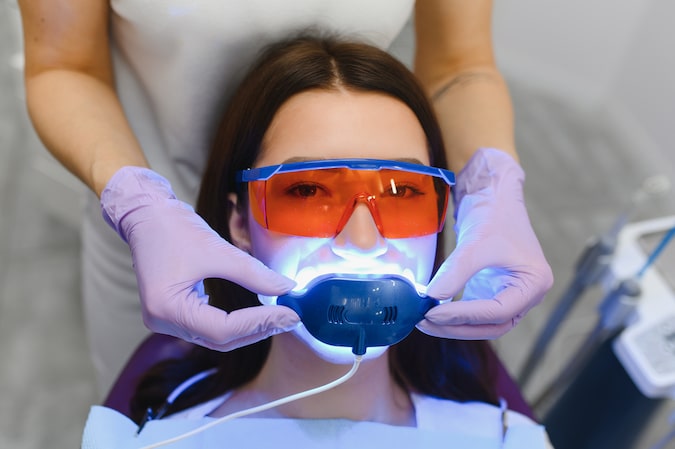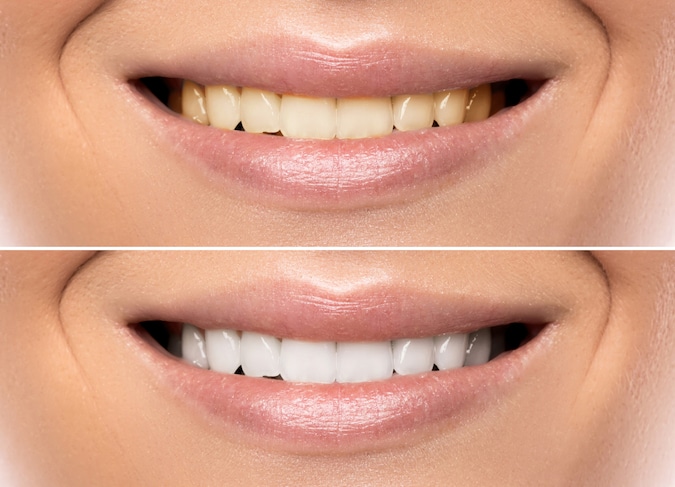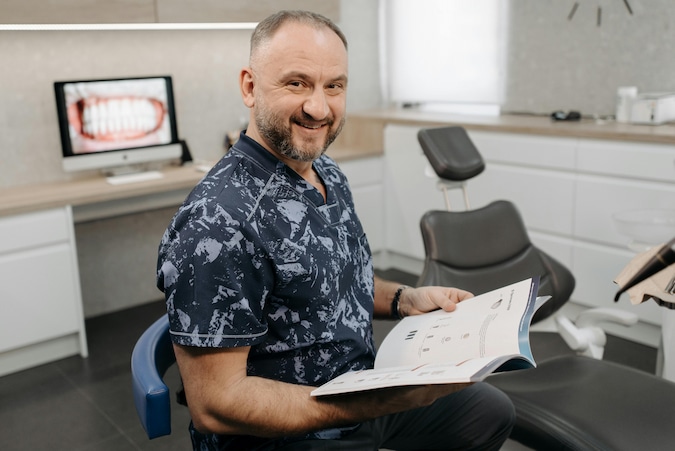
Teeth Whitening Options and Procedures for a Brighter Smile

Are you looking for a brighter, whiter smile? Teeth whitening offers safe and effective solutions to improve the appearance of your teeth. From in-office treatments to at-home remedies, understanding these options can help you make the best choice for a lasting, confident smile.
Teeth whitening is a popular cosmetic procedure designed to eliminate stains and discoloration, resulting in a radiant, fresh look. With so many options available, from professional treatments to natural remedies, SelfGood is here to guide you through the most effective teeth whitening procedures. Whether you’re considering a quick in-office treatment or a gradual at-home method, we cover all the details you need to know.
Key Takeaways:
- Teeth whitening is a safe and effective way to improve dental aesthetics.
- Different whitening methods suit different needs, from fast results to gentle, gradual brightening.
- Understanding risks, maintenance, and expected results helps in choosing the best method for you.
Understanding Why Teeth Become Discolored

Several factors contribute to tooth discoloration:
- Aging: The natural aging process wears down enamel, allowing yellow dentin to show through.
- Diet: Coffee, wine, tea, and foods high in pigmentation can stain teeth over time.
- Smoking and Tobacco Use: Nicotine and tar in tobacco products are known for causing yellow and brown stains.
- Medications: Some medications, including certain antibiotics, can lead to intrinsic discoloration.
Understanding the root cause of discoloration is essential for choosing the most effective whitening treatment.
In-Office Professional Whitening Treatments
Professional whitening treatments are performed in a dentist’s office and deliver rapid, lasting results.
Laser Whitening
Laser whitening involves applying a bleaching gel to the teeth and activating it with a specialized laser. This procedure is quick and effective, often requiring only one session to achieve noticeable results. However, it can be costly, typically ranging from $500 to $1,000. Laser whitening is ideal for those seeking immediate and dramatic whitening.
Zoom Whitening
Zoom whitening is another popular in-office treatment. It uses a hydrogen peroxide-based gel, activated by a special light, to enhance whitening effects. The process takes about 45 minutes, and patients usually see visible improvement after one session. The cost for Zoom whitening ranges from $300 to $600. Although effective, it may require more frequent maintenance for lasting results.
Custom Whitening Trays
Some dentists offer custom-fitted trays for at-home use. These trays, made to fit the patient’s teeth, provide even gel distribution for a more controlled whitening experience. Custom trays usually cost between $200 and $400 and are an affordable way to get professional results with the convenience of at-home application.
At-Home Whitening Kits
At-home whitening kits are an affordable, flexible option that provides gradual results. However, they may not be as effective as in-office treatments.
Whitening Trays and Gels
Over-the-counter whitening trays are filled with a peroxide-based gel and fitted over the teeth. These trays are more affordable than professional options, costing between $20 and $100. Results generally take a few weeks, and regular use can lead to a significantly whiter smile. However, due to a less precise fit, they may cause mild irritation or uneven whitening.
Whitening Strips
Whitening strips are coated with a gel that contains peroxide. These strips are applied to the teeth for about 30 minutes per session and are a popular choice for their convenience and affordability. Results usually become visible within one to two weeks, and they typically cost between $10 and $50. While whitening strips are effective, they may only cover the front teeth and could cause sensitivity.
LED Whitening Kits
LED whitening kits use a light source to enhance the effects of the whitening gel, accelerating results. These kits are popular for home use, typically priced between $50 and $150, and offer results after a few sessions. While LED kits are convenient, they may lead to tooth sensitivity if overused.
Natural Teeth Whitening Remedies
Natural remedies for teeth whitening are gentler, though generally less effective than professional or at-home kits.
Baking Soda and Hydrogen Peroxide
A common at-home remedy, baking soda, and hydrogen peroxide can be mixed into a paste for brushing. Used sparingly, this can help remove surface stains. However, overuse may wear down enamel, so it should be applied cautiously.
Coconut Oil Pulling
Swishing coconut oil in the mouth, known as oil pulling, may reduce plaque and bacteria, which can brighten teeth over time. While oil pulling is safe and promotes oral health, its whitening effects are usually mild and slow.
Activated Charcoal
Activated charcoal is another popular method, but it’s abrasive and may erode enamel if used frequently. While it can remove surface stains, it’s best used occasionally and with professional guidance.
Risks and Side Effects of Teeth Whitening

While generally safe, teeth whitening can cause certain side effects:
- Tooth Sensitivity: Whitening treatments can temporarily increase sensitivity to hot and cold foods.
- Gum Irritation: Bleaching agents may irritate gums, especially if trays or strips aren’t applied correctly.
- Enamel Damage from Overuse: Excessive whitening can damage enamel, increasing long-term sensitivity.
To minimize risks, consult a dentist before starting any whitening treatment, especially if you have existing sensitivity or dental issues.
Choosing the Best Whitening Method for You
When selecting a whitening method, consider the following:
- Budget: Professional whitening costs more than at-home treatments.
- Desired Intensity: Professional treatments deliver more dramatic results than over-the-counter solutions.
- Sensitivity Concerns: Some methods may increase sensitivity; if this is a concern, opt for milder treatments.
- Maintenance Needs: Some methods require regular touch-ups to maintain results.
Longevity of Whitening Results
The duration of teeth whitening results depends on the method used and individual habits.
- In-Office Treatments: Results from professional whitening may last one to three years with proper maintenance.
- At-Home Kits: Results from over-the-counter products typically last a few months to a year.
- Natural Remedies: Effects are mild and may require consistent application to see gradual improvement.
To extend results, avoid foods and drinks that stain teeth, practice good oral hygiene, and consider using whitening toothpaste between treatments.
Alternatives to Whitening for Dental Brightness
For those who may not be ideal candidates for whitening, alternative cosmetic solutions are available:
- Veneers: Thin porcelain layers cover the teeth’s front surface, creating a bright, white appearance.
- Bonding: Bonding uses composite resin to cover discoloration and shape the teeth.
- Professional Cleanings: Routine cleanings can help remove surface stains and polish teeth, creating a brighter appearance.
These alternatives are particularly suitable for individuals with severe intrinsic staining or other dental health concerns.
Final Thoughts
Achieving a brighter smile is accessible through a variety of teeth whitening methods, from professional treatments to natural solutions. By understanding the pros and cons of each option, as well as considering your own budget, sensitivity level, and maintenance preferences, you can find the best approach to reach your desired results. Consulting a dental professional ensures a safe, effective, and tailored whitening experience.
Frequently Asked Questions
How safe is teeth whitening?
Teeth whitening is generally safe when performed under a dentist’s supervision or when using over-the-counter products as directed. Professional treatments are safer for those with sensitive teeth or gum issues.
Can teeth whitening remove all types of stains?
Teeth whitening is effective on extrinsic (surface) stains but may not fully remove intrinsic stains, like those caused by medications. Professional consultations can help identify the right treatment for specific stains.
How often can I whiten my teeth safely?
Most dentists recommend professional whitening once or twice a year, depending on your sensitivity and maintenance practices. Over-the-counter products may be used more frequently, but it’s best to avoid excessive treatments to prevent enamel erosion.
Sources:
- American Dental Association. (n.d.). Teeth Whitening Options.
- Mayo Clinic. (n.d.). Understanding Causes of Tooth Discoloration.
- Healthline. (n.d.). Risks and Side Effects of Teeth Whitening Procedures .




